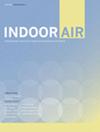Combining Chamber Experiments and Model Simulations to Evaluate an Indoor HONO Source with Surface Photochemical Properties
Abstract
Nitrous acid (HONO) is an emerging indoor pollutant that can exert adverse health effects. The chemical production of indoor HONO has been attributed to NO2 heterogeneous reactions, and the source strength has been extensively evaluated via laboratory and model simulation studies. Photolysis of surface nitrate has recently been proposed as an indoor HONO source based on correlation analysis between indoor HONO accumulation and visible light radiation. However, neither experimental validation of the proposed mechanism nor source strength characterization is currently available. In this work, we designed an outdoor photochemical chamber (OPC) to simulate indoor HONO accumulation and established an indoor photochemical model (ICM) to calculate the indoor HONO budget. Indoor HONO accumulation revealed a distinct diel variation with a daytime maximum. Only with this indoor HONO source, the ICM reproduced the indoor HONO budget determined in the OPC. The enhanced reactive cross section of surface nitrate in visible light accounted for the major portion of the HONO source budget (77.2%) and the distinct diel variation. Success with the ICM encouraged us to simulate the HONO budget in real indoor environments. The calculated HONO production rates from surface nitrate photolysis at noon ranged from 1.4 to 4.1 ppbv h-1 under different indoor scenarios. On a daily average, this indoor HONO source contributed 42.4–52.7% to the total chemical sources in the living room but only contributed 4.7% to that in the kitchen, where NO2 heterogeneous reactions dominated.


 求助内容:
求助内容: 应助结果提醒方式:
应助结果提醒方式:


